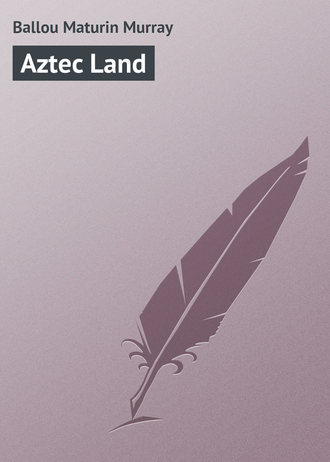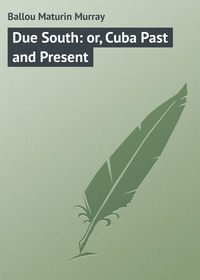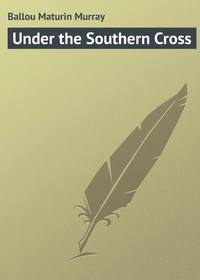 полная версия
полная версияAztec Land
Vegetables, charcoal, fruit, and market produce generally are brought into the town from various distances on the backs of the natives. These Indians will tire the best horse in the distance they can cover in the same length of time, while carrying a hundred pounds and more upon their backs. Mules and donkeys are also much in use, but the lower classes of both sexes universally carry heavy burdens upon their backs from early youth. Some of the Indian women are seen bearing loads of pottery or jars of water upon their shoulders with seeming ease, under which an ordinary Irish laborer would stagger. Comparatively few wheeled vehicles are in use, and these are of the rudest character, the wheel being composed of three pieces of timber, so secured together as to form a circle, but having no spokes or tire, very like the ancient African and Egyptian models. To such a vehicle a couple of oxen are attached by a wooden bar reaching across their frontlets and lashed to the roots of the horns by leather thongs. The skins of animals, such as goats, sheep, and swine, are universally employed for transporting and storing liquids, precisely as in Egypt thousands of years ago. The daily supply of pulque is brought to market on the natives' backs in pig-skins, the four legs protruding from the body in a ludicrous manner when the skin is full of liquid. Everything in and about the city is quaint, though the telephone, electric lights, and street tramways all speak of modern civilization. The insufficient water supply is the cause of much inconvenience, not to say suffering, and partly accounts for the untidy condition of the place and the prevalence of offensive smells. The latter are so disgusting as to be almost unbearable by a stranger. No wonder that typhoid fever and kindred diseases prevail, and that the death rate exceeds, as we were told is the case, that of any other district in the republic.
There is an article of pottery manufactured in this vicinity, of a deep red color, hard-baked and glazed inside and out, having rude but effective ornamentation. Almost every large town in Mexico has one or more pottery manufactories, each district producing ware which is so individualized in the shape and finish as to distinctly mark its origin, so that experts can tell exactly whence each specimen has been brought. The manufacture of pottery is most frequently carried on by individuals, each Indian with his primitive tools turning out work from his mud cabin sometimes fit to grace the choicest and most refined homes. The accuracy of eye and hand gained by long practice produces marvelous results.
Overlooking the city, on a mountain ridge known as the Büfa, is a quaint and curious church, Los Remedios. From this point one obtains a very comprehensive view of the entire valley and the surrounding rugged hills. One of the most bloody battles of the civil wars was fought on the Büfa in 1871, between a revolutionary force under General Trevino and the Juarez army, which resulted in the defeat of the revolutionists. "Both sides fought with unprecedented frenzy," said a resident to us. "From those steep rocks," he continued, pointing to the abrupt declivities, "absolutely ran streams of blood, while dead bodies rolled down into the gulch below by hundreds." We ventured to ask what this quarrel between, fellow countrymen was about that caused such a loss of life and induced such a display of enthusiastic devotion. "That is a question," he replied, "which the rank and file of either army could not have answered, though of course the leaders had their personal schemes to subserve, – schemes of self-aggrandizement." It was Lamartine who said significantly, "Civil wars leave nothing but tombs."
It is the custom for a stranger to descend one or more of the silver mines; indeed, it may be said to be the one thing to do at Zacatecas, but for which only the most awkward means imaginable are supplied, such as ladders formed of a single long, notched pole, quite possible for an acrobat or performer on the trapeze. It is up and down these hazardous poles that the Indian miners, in night and day gangs, climb, while carrying heavy canvas bags of ore weighing nearly or quite two hundred pounds each. The writer is free to acknowledge that he did not improve the opportunity to explore the bowels of the earth at Zacatecas, having performed his full share of this sort of thing in other parts of the world.
Zacatecas has its plaza; all Spanish and Mexican towns have one. Probably, in laying out a town, the originators first select this important centre, and then all other avenues, streets, and edifices are made to conform to this location. In the middle of this plaza is a large stone fountain, about which groups of native women are constantly busy dipping water and filling their earthen jars, while hard by other women, squatting on their haunches, offer oranges, pineapples, figs, and bananas for sale. How these Mexican markets swarm with people and glow with color, backed by moss-grown walls and ruined archways! Long burro trains block the roadway, and others are seen winding down the zigzag paths of the overhanging declivities. Close at hand within these low adobe hovels, pulque is being retailed at a penny a tumbler. It is the lager-beer of the country. Poverty, great poverty, stares us in the face. No people could be more miserably housed, living and sleeping as they do upon the bare ground, and owning only the few pitiful rags that hang about their bodies. At the doors of these mud cabins women are seen making tortillas with their rude stone implements. These little flat cakes are bread and meat to them. Now and again one observes forms and faces among the young native women that an artist would travel far to study; but although some few are thus extremely handsome, the majority are very homely, ill-formed, and negligent of person. The best looking among the peons lose their comeliness after a few years, owing to hard labor, childbirth, and deprivations. Few women retain their good looks after twenty-five years or until they are thirty. Another fact was remarked, that these Indian men and women never laugh. The writer was not able to detect even a smile upon the faces of the lower grade of natives; a ceaseless melancholy seems to surround them at all times, by no means in accordance with the gay colors which they so much affect. In contrast to the hovels of the populace, one sees occasionally a small garden inclosed with a high adobe wall, belonging to some rich mine owner, in which the tall pomegranate, full of scarlet bloom, or a stately pepper tree, dominates a score of others of semi-tropical growth.
One practice was observed at Zacatecas which recalled far-away Hong Kong, China. This was the prosecution of various trades in the open air. Thus the shoemaker was at work outside of his dwelling; the tailor, the barber, and the tinker adopted the same practice, quite possible even in the month of March in a land of such intense brightness and sunshine. We wandered hither and thither, charmed by the novelty and strangeness of everything; not an object to remind one of home, but only of the far East. The swarthy natives with sandaled feet, the high colors worn by the common people, the burnous-like serape, the sober unemotional manners of the peons, the nut-brown women with brilliant eyes and half-covered faces, the attractive fruits, the sharp cries of the venders, the Egyptian-shaped pottery, – surely this might be Damascus or Cairo.
An excursion by tramway was made to the neighboring town of Guadalupe, six or eight miles away, nearly the entire distance being a sharp down grade, over which the cars pass at top speed by their own gravitation; no animals are attached. So steep is the descent that it may be compared to a Canadian toboggan slide. It requires six mules to draw each car back again, the animals being harnessed three abreast like the horses in the Paris and Neapolitan omnibuses. Though this tramway is now admitted to be an indispensable adjunct to the business of the place, when it was first resolved upon by some of the residents more enterprising than their neighbors, it was considered to be a serious innovation, open to great objections, the local priesthood bitterly opposing it. Even the moneyed mine owners and others who instituted the project had no fixed idea how to operate a tramway of this sort, and an American overseer was from the beginning and is to-day in charge. The cars were ordered from Philadelphia, and while they were building, the steel rails, which came from Liverpool by way of Vera Cruz, were laid down from one end of the route to the other. Finally, when the cars arrived from the United States, it was found that they would not run on the track, the fact being that the rails had been laid on a gauge three inches narrower than the cars were designed for. What was to be done? The Mexicans at first proposed to rebuild the cars, – make the bodies narrower, and cut off the axle-trees to fit the gauge of the rails. In their hopeless ignorance this was the only way they could see out of the difficulty. The present superintendent, a practical American engineer, was at the time in Zacatecas, and took in the position of affairs at a glance, offering for five hundred dollars to show the owners how to get out of the trouble without changing an article upon the cars. The money was paid, and with twenty men and some suitable tools the American took up a few rods of the track, made a proper gauge for the rest, and had the cars running over the short distance in one day. It was the old story of Columbus and the egg, easy enough when one knew how to do it. The managers of the road promptly put the American in charge, and he has filled the position ever since.
Guadalupe is an interesting town of some six thousand inhabitants, not counting the myriads of dogs, which do much abound in every part of Mexico. As a rule these are miserable, mangy-looking, half-starved creatures, with thin bodies and prominent ribs. The poorer the people, the more dogs they keep, a rule which applies not only here, but everywhere, especially among semi-barbarous races. The people seem to be very kind to pet animals, – though they do abuse the burros, – cats especially being of a plump, handsome species, quite at home, always sleeping lazily in the sunshine. If they do purr in Spanish, it is so very like the genuine English article that its purport is quite unmistakable. The persistency of the beggars here attracted attention, and on inquiry about the matter, a resident American informed us that these beggars were actually organized by the priests, to whom they report daily, and with whom they share their proceeds, thus enriching the plethoric coffers of the church. This seems almost incredible; but it is true. The decencies of life are often ignored, and the open streets present disgusting scenes. Men and women lie down and sleep wherever fatigue overcomes them, upon the hard stones or in the dirt. The town is generally barren of vegetation, though a few dreary cactus trees manage to sustain themselves in the rocky soil, with here and there a yucca palm.
There is a famous orphan asylum in Guadalupe which is designed to accommodate a thousand inmates at a time, and there is also a well-endowed college. The former of these, the Orfanatorio de Guadalupe, is one of the most important charitable institutions in the republic. The old church of red sandstone, with its somewhat remarkable carvings, as exhibited upon the façade, has two graceful towers and is elaborately finished within. The church contains a half dozen oil paintings by Antonio de Torres, which bear the date 1720. The finest of these is that of "The Last Supper." The very elegant interior of the chapel of the Purisima was not completed until so late as 1886, and is justly considered the finest modern church structure in Mexico. As one passes out into the surrounding squalor and obtrusive poverty, it is impossible not to moralize as to the costly, theatrical, and ostentatious road which seems to lead to the Roman Catholic heaven.
The little market-place of Guadalupe presents a scene like a country fair, with its booths for the sale of fruits, pottery, vegetables, flowers, bright-hued serapes and rebosas, all combining to form a conglomerate of color which, mingled with the moving figures of the mahogany-hued Indian women, is by no means devoid of picturesqueness. One must step carefully not to tread upon the little mounds and clusters of fruits and vegetables spread upon the ground for sale. The careless, happy laugh of a light-hearted group of señoritas rang musically upon the ear as we watched the market scene. Their uncovered, purple-black hair glistened in the warm sunlight, while their roguish glances, from "soul-deep eyes of darkest night," were like sparks of electricity. Was it their normal mood, or did the presence of a curious stranger, himself on the qui vive to see everything, move them to just a bit of coquetry?
CHAPTER V
A Mexican Watering Place. – Delightful Climate. – Aguas Calientes. – Young Señoritas. – Local City Scenes. – Convicts. – Churches. – A Mummified Monk. – Punishment is Swift and Sure. – Hot Springs. – Bathing in Public. – Caged Songsters. – "Antiquities." – Delicious Fruits. – Market Scenes. – San Luis Potosi. – The Public Buildings. – City of Leon. – A Beautiful Plaza. – Local Manufactories. – Home Industries of Leon. – The City of Silao. – Defective Agriculture. – Objection to Machinery. – Fierce Sand Storm.
Aguas Calientes (hot waters) is the capital of a small state of the same name, and is a very strongly individualized city, containing something less than twenty-five thousand inhabitants. The town is handsomely laid out with great regularity, having a number of fine stone buildings, luxuriant gardens, and beautiful public squares. It is situated seventy-five miles south of Zacatecas, on the trunk line of the Mexican Central Railroad. This route brings us down to the plain through rugged steeps and sharp grades, near to the famous salt and soda lakes, where the Rio Brazos Santiago is crossed. Though we say that Aguas Calientes is on a plain, yet the town is over six thousand feet above sea level, and is well situated for business growth in a fertile region where three main thoroughfares already centre. It is just three hundred and sixty-four miles northwest of the city of Mexico. The Plaza des Armas, with its fine monumental column and its refreshing fountain, as well as several other public gardens of the city, are worthy of special mention for their striking floral beauty, their display of graceful palms and various other tropical trees. It seemed as though it must be perpetual spring here, and that every tree and bush was in bloom. The Mexican flora cannot be surpassed for depth of rich coloring. Sweet peas, camellias, poppies, and pansies abound, while oleanders grow to the height of elm trees, and are covered with a profusion of scarlet and white flowers. The day was very soft, sunny, and genial, when we wandered over the ancient place; all the treetops lay asleep, and there was scarcely a breath of air stirring. Every sight and every sound had the charm of novelty. Groups of young señoritas strolled leisurely about the town; their classic profiles, large gazelle-like eyes, rosy lips, delicate hands and feet, together with their shapely forms, indicated their mingled Spanish and Indian origin. The many sonorous bells of the churches kept up a continuous peal at special morning and evening hours. In spite of the half-incongruous notes of these different metallic voices floating together on the atmosphere, there was a sense of harmony in the aggregate of sound, which recalled the more musical chimes one hears on the shores of the Mediterranean. Mexican churches are not supplied with chimes, though each steeple has at least a half dozen, and often as many as a score, of costly bells.
Here and there the town shows unmistakable tokens of age, which is but reasonable, as it was founded in 1520. The variety of colors used upon the façades of the low adobe houses produces a pleasing effect. The love of the Aztec race for warm, bright colors is seen everywhere. The Garden of San Marcos, one of many open public squares, forms a wilderness of foliage and flowers, where the oleanders are thirty feet in height, shading lilies, roses, and pansies, with a low-growing species of mignonette as fragrant as violets, our admiration for which was shared by a score of glittering humming-birds. Here too the jasmine, with its tiny variegated flowers, flourished by the side of hydrangeas full of snow-flake bloom, while orange blossoms made the air heavy with their odorous breath. Close to this garden is the bull ring, opposite to which gangs of convicts are seen sweeping the streets under the supervision of a military guard. Though these men are unchained, they make no attempt to escape, as the guards under such circumstances have a habit of promptly shooting a prisoner dead upon the spot; no one takes the trouble to inquire into the summary proceeding, and it would do no good if he did. There is no sickly sentimentality expended upon highwaymen, garroters, or murderers in Mexico. If a man commits a crime, he is made to pay the penalty for it, no matter what his position may be. There is no pardoning out of prison here, so that the criminal may have a second chance to outrage the rights of the community. If a trusted individual steals the property of widows and orphans and runs away, he must stay away, for if he comes back he will surely be shot. All things considered, we believe this certainty of punishment is the restraining force with many men of weak principles. Since the order to shoot all highwaymen as soon as taken was promulgated, brigandage has almost entirely disappeared in Mexico, though up to that time it was of daily occurrence in some parts of the country.
There are several churches in Aguas Calientes which are well worth visiting, some of which contain fine old paintings, though they are mostly hung in a very poor light. There is an unmistakable atmosphere of antiquity within these walls, "mellowed by scutcheoned panes in cloisters old." The church facing the Plaza Mayor has a remarkable bell, celebrated for its fine tones; and when this sounded for vespers, Millet's Angelus was instantly recalled, the poor peons, no matter how engaged, piously uncovering their heads and bowing with folded hands while their lips moved in prayer. We were told of the great cost of this bell, which is said to contain half a ton of silver; but this is doubtless an exaggerated story framed to tickle a stranger's ear, since if over a certain moderate percentage of silver is employed in the casting, the true melody of the bell is destroyed. A queer object is shown the visitor for a trifling fee, in the crypt of the church of San Diego, being the remains of a mummified or desiccated monk, sitting among a mass of skulls, rib and thigh bones, once belonging to human beings. The moral of this exhibition seemed a little too far-fetched to be interesting, and our small party hastened away with a sense of disgust.
The hot springs from which the state and city take their name are situated a couple of miles east of the town, at the end of a delightful alameda. A small canal borders this roadway, which is liberally supplied with water from the thermal springs, and scores of the populace may be seen washing clothing on its edge at nearly any hour of the day, as well as bathing therein, men and women together, with a decided heedlessness of the conventionalities. The Maoris of New Zealand could not show more utter disregard for a state of nudity than was exhibited by one group of natives whom we saw. The admirable climate, the hot springs, the beautiful gardens, vineyards, and abundant fruits, render this place thoroughly attractive, notwithstanding that so large a portion consists of adobe houses of only one story in height. These are often made inviting by their neat surroundings and by being frescoed in bright colors inside and out. One or two native birds in gayest colors usually hang beside the open doors, in a home-made cage of dried rushes, singing as gayly as those confined in more costly and gilded prisons. Just opposite the public baths was one of these domesticated pets of the mocking-bird species, who was remarkably accomplished. He was never silent, but was constantly and successfully struggling to imitate every peculiar sound which he heard. He broke down, however, ignominiously in his attempts with the tramway fish-horns. They were too much for him. This bird was of soft ash color, with a long, graceful set of tail-feathers, and kept himself in most presentable order, notwithstanding his narrow quarters in a home-made cage. It was in vain that we tried to purchase the creature. Either the Indian woman had not the right to sell him, or she prized the bird too highly to part with him at any price. As we came away from the low adobe cabin, the bird was mewing in imitation of another domestic pet which belonged to the same woman.
Comparatively few humble dwellings have glass in the windows, but nearly all have these openings barred with iron in more or less ornamental styles. There are a few central situations where two-story houses prevail. Besides the churches, there are the governor's palace, the casa municipal, and the stores and dwelling-houses which surround the Plaza Mayor, the latter having open arcades, or portales, beneath the first story. People come from various parts of Mexico to enjoy the baths of Aguas Calientes, and one sees many strangers about the town. The place has, in fact, been the resort of people from various sections of the country from time immemorial, on account of the presumed advantages to be derived from the hot springs. Mineral waters, hot and cold, abound on the table-land of Mexico.
It is said that by digging almost anywhere in this neighborhood, one can exhume pottery and other articles concerning whose manufacture there is a profound mystery, the shapes and style of finish being quite different from what is now produced. These articles are reputed to antedate the Toltec period, though the natives, finding that the antique shapes are most popular with European and American tourists, imitate them very closely. When "antiquities" are offered to one in a foreign country, he should be very wary in purchasing, as the artificial manufacture of them is fully up to the demand. The writer once saw an article sold at Cairo as an antique for ten pounds sterling which was afterwards proved, by an unmistakable mark, to have been made in Birmingham, England. So Aztec and Toltec remains are produced to any extent in the city of Mexico; and the enterprising English manufacturer, we were told, has even invaded Yucatan with his "antique" wares.
Fruit is abundant, cheap, and delicious in the market-place of Aguas Calientes. Fifty oranges were offered to us for a quarter of a dollar, or two for a penny. Sunday is the principal market-day, when the country people for miles around bring in fruit, vegetables, flowers, pottery, and home-woven articles for sale. Men and women, sitting on the ground, patiently wait for hours to make trifling sales, the profit on which cannot exceed a few pennies, and often the poor creatures sell little or nothing. The principal market is a permanent building, occupying a whole block, or square. The area about which it is built is open in the centre; that is, without covering. Here a motley group displayed baskets, fruits, flowers, candies, pulque, boots, shoes, and sandals. White onions mingled with red tomatoes and pineapples formed the apex to a pyramid of oranges, bananas, lemons, pomegranates, all arranged so as to present attractive colors and forms, being often decked with flowers. Green sugar-cane, cut in available lengths, was rapidly consumed by young Mexico, and gay young girls indulged in dulces (sweets). Hundreds of patient donkeys, without harness of any sort, or even a rope about their necks, stood demurely awaiting their hour of service. Beggars are plenty, but few persons were seen really intoxicated, notwithstanding that pulque is cheap and muscal very potent. Red, blue, brown, and striped rebosas flitted before the eyes, worn by the restless crowd, while occasionally one saw a lady of the upper class, attended by her maid in gaudy colors, herself clad in the dark, conventional Spanish style, her black hair, covered with a lace veil of the same hue, held in place by a square-topped shell comb.
The public bathhouse, near the railroad depot, is remarkable for spaciousness and for the excellence of the general arrangements. It is built of a conglomerate of cobble-stones, bricks, and mortar, and might be a bit out of the environs of Rome. In the central open area of these baths is a choice garden full of blooming flowers and tropical trees. Oleanders, fleurs-de-lis, flowering geraniums, peach blossoms, scarlet poppies mingling with white, beside beds of pansies and violets, delighted the eye and filled the air with perfume. The surroundings and conveniences were more Oriental than Mexican, inviting the stranger to bathe by the extraordinary facilities offered to him, and captivating the senses by beauty and fragrance. There is a spacious swimming-bath within the walls, beside the single bathrooms, in both of which the water is kept at a delightful temperature. The luxury of these baths, after a long, dusty ride over Mexican roads, can hardly be imagined by those who have not enjoyed it. In the vicinity of the Plaza Mayor, ice-cream was hawked and sold by itinerant venders. We were told of a mysterious method of producing ice, which is employed here during the night, by means of putting water in the hollowed stalk of the maguey or agave plant, but we do not clearly understand the process. The volatile oil of the century plant is said to evaporate so rapidly as to freeze the water deposited in it. At any rate, the natives have some process by which they produce ice in this tropical clime; but whether it is by aid of the maguey plant, from which comes the pulque, or by some other means, we cannot say authoritatively. In the cities and on the Texan border, ice is largely manufactured by chemical process aided by machinery, a means of supply well known in all countries where natural ice is not formed by continued low temperature.









